Boxwood Blight
Boxwood blight is the disease making headlines. This disease is a relatively new player in the Chicagoland region, and is more prevalent on the East Coast where it was first found in 2011. Boxwood Blight was discovered in Northern IL in 2016, and since then only three confirmed cases have been reported to the IL Dept of Agriculture (all have been successfully quarantined). The causal fungus, Calonectria pseudonaviculata, is referred to as a “sticky spore,” referring the fact that it mainly travels between host by hitching a ride on passing people, animals, or equipment. Initial symptoms show as dark spotting on infected leaves, which eventually grow to consume the entire leaf. The undersides of infected leaves and stems produce visible white spores following appropriate environmental conditions (warm and humid). The infection will quickly spread to the entire plant, causing rapid defoliation. A key identification of this infection is the black streaks that form on infected stems. While the disease does not infect root systems, its spores are able to survive up to five years once they fall to the ground.
Commonly the disease is introduced to new areas via infected nursery stock that has not yet shown symptoms. Once a plant is infected there is no cure, and the recommended action is to quarantine and remove all infected material. However, this should be done by a professional in order to reduce the further spread of the disease. There are preventative spray treatments available for healthy boxwood, but due to the aggressive spray program required for control, this is only recommended if the disease has been found within your neighborhood. The best management practice for this disease is prevention of introduction to your landscape, which is achieved through vigilant sanitation of pruning equipment and purchasing boxwood from reputable nurseries that routinely check for the disease.
It is highly unlikely that your boxwood have this disease. If your boxwood are looking tattered this spring, they more likely are suffering from one or more of the following ailments.
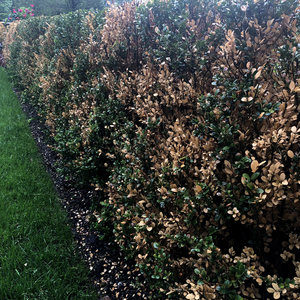
Typical winter injury on a boxwood hedge. The damage is focused on outer most growth and has a clean, bronzed appearance.
Winter Injury
Environmental damage has been extremely common this spring due to the harshness of the past winter. Winter damage can be cause by either excessive respiration which dries out the leaves, or by exposure to temperatures colder than its hardiness rating. Both result in a similar look: dried leaves starting from the outermost stems working inward, giving portions of the plant an alarming bronze or straw colored sheen. Additionally, late season snow events can cause flowing sap under the bark to freeze rapidly and expand, which physically blows the bark off the stem and girdles any live tissue terminal. Depending on the level of damage, some boxwood can recover from this one-time event. You may notice new growth forming on the interior of the plant, on the stem area just interior to where the dieback occurred. By carefully pruning the deadwood and exposing this new growth, you can successfully encourage new stems to fill the hole(s) caused by winter damage. However, you will need to be patient- boxwood grow very slowly and may take several years to regain their original shape.
You can reduce winter damage by applying an anti-desiccant spray.This oil is specially formulated to coat the evergreen leaves in a layer of wax and reduce drying out on sunny winter days.Additionally, you can plant cultivars such as “Green Velvet” that are comparatively more hardy than other cultivars available on the market.Winter damage can have devastating effects if compounded with additional stresses of other pathogens mentioned below.
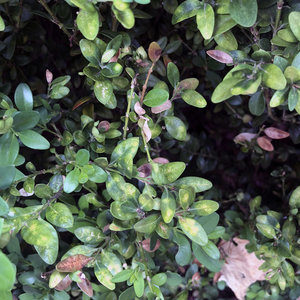
Boxwood leaf miner damage on new plant growth.
Boxwood Leaf Miner
Boxwood Leaf Miner is a very small insect (barely visible with a hand lens) whose larval stage feeds on the inner leaf space between layers of plant cells. Its feeding causes a circular discoloration and “blisters” to form on the leaves, with eventual leaf mortality. These foliar symptoms can be superficially similar to that of Boxwood Blight. However, if you suspect leaf miner damage you can physically peel apart the layers of the leaf to expose the yellow larva feeding on the leaves. On a plant with excessive infestation, you can sometimes hear a crackling noise emitting from the foliage as larvae are feeding.
Under normal conditions, this insect exists in low levels that would not warrant treatment.Occasionally, the insect will experience population swings and cause a localized outbreak.The Chicagoland area is currently experiencing a several year-long outbreak of this insect, and the damage can be severe enough to stress the boxwood host to the edge of death.This allows other, typically opportunistic diseases to move in and kill the plant.The control is either a contact insecticide applied as adults emerge in late spring, or a systemic insecticide applied in the spring or fall when larvae are feeding on the leaves.Several years of applications are required to see a positive affect, as feeding damage that appears in the spring/summer was likely caused by larva in the previous year.
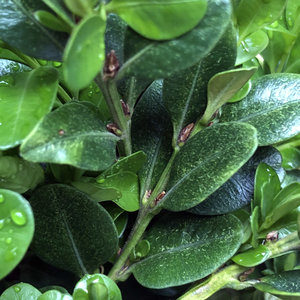
Spider mite damage on boxwood growth appears as a speckled, lighter color on otherwise healthy leaves.
Boxwood Spider Mites
Boxwood spider mite is commonly found on most species of boxwood. The mite, which overwinters as eggs on the underside of leaves, will hatch in May and immediately begin feeding on both the top and bottom sides of infected leaves. The feeding damage looks like a speckled pattern on the topside of leaf, as if someone has poked hundreds of tiny holes causing little tan colored spots to coat the entire leaf. Unlike many other spider mites, the boxwood spider mite does not produce significant quantities of webbing, so that cannot be used to identify their presence.
Mite feeding is most severe in years with excessive dry spells.Boxwood spider mites prefer the mild temperature of spring and early summer, and the feeding will slow when the temperature spikes. Due to the mites’ love of dry weather, a wet spring can adequately stymie their populations.For chemical control, these mites are best eradicated through multiple applications of either a dormant oil to kill overwintering eggs, or a mid-season miticide to target feeding adults.In a healthy landscape, natural predators should be able to keep spider mite populations in check.
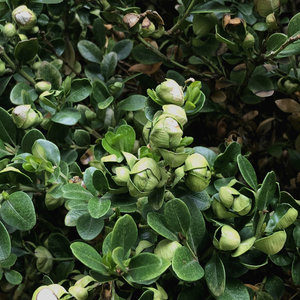
Boxwood psyllid damage causes cupping of terminal leaves of stems.
Boxwood Psyllid
The boxwood psyllid is a common insect pest of nearly all boxwood, but especially of our American species, Buxus sempervirens. The insect overwinters in bud scales, the overwintering plant structure that produces new growth in the spring and emerges as plants leave dormancy in May. As the crawler stage of the insect feeds on new growth, it causes a noticeable cupping habit to form on the newest leaves. This cupping action provides a safe environment for further feeding and eventual molting of the nymph into adults. The damage is considered purely aesthetic.
Normally psyllid damage is not observed in formal hedges where new growth is routinely removed. Psyllid control is easily achieved with a springtime insecticide when the nymphal stage is feeding, and rarely requires repeat application. However, when coupled with other pests, this insect can contribute to overall plant mortality and should be controlled when noticed.
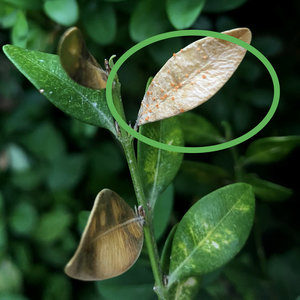
Volutella blight causes characteristic salmon colored fungal spores to appear on infected plant tissue.
Volutella Blight
Volutella Blight, sometimes referred to as Pseudonectria canker, is a common opportunistic fungal disease. It primarily infects stressed boxwood that has previously experienced winter injury, insect damage or excessive pruning. Volutella Blight has similar symptoms to boxwood blight, a much more serious fungal disease. The initial symptoms show little to no spring growth, often with the existing leaves becoming an orange or reddish color (indicating stress). Eventually, a stem canker will form causing the girdling and eventual death of the terminal stem. The canker will frequently cause the bark of the stem to peel off, leaving no chance for the terminal stem to recover. Unique to volutella blight is the salmon colored spores that form on infected stems and leaves during periods of high humidity. Another way to distinguish this disease from boxwood blight is by whether the leaves of infected stems are still present. Volutella blight infections will cause the leaves to stay on the stems for a significant period after death, whereas boxwood blight causes an alarmingly fast defoliation when conditions are right.
Once infected, you cannot cure and save the infected stem, but healthy stems can be preventatively treated with a spring fungicide. Since volutella blight is an opportunistic disease, the long-term cure is to promote healthy plant vigor through good cultural practices. Make sure your boxwood are adequately fertilized, and only water via drip irrigation or bubbler when needed. Boxwood do not like wet “feet” and suffer when prolonged rains cause saturated soils.
Boxwood are a favorite plant choice among many landscapes on the North Shore. This popularity has its’ drawbacks. Excessive monoculture planting can leave our collective urban landscape susceptible to a wide range of insects and diseases. It is not uncommon to see the same pathogen affecting multiple landscapes within the same neighborhood due to their proximity. However, most of the ailments described are treatable with the right diagnosis and care. For now, the spread of boxwood blight is successfully limited in the Chicagoland region through vigilant Arborist scouting and prompt ILDA response. It has the potential to be more prevalent in the landscape, but is currently highly unlikely to be affecting your boxwood. If your boxwood are struggling, it’s best to call your local certified Arborist to have a professional diagnosis. This allows the correct pathogen to be identified, and the proper treatment to be prescribed.
